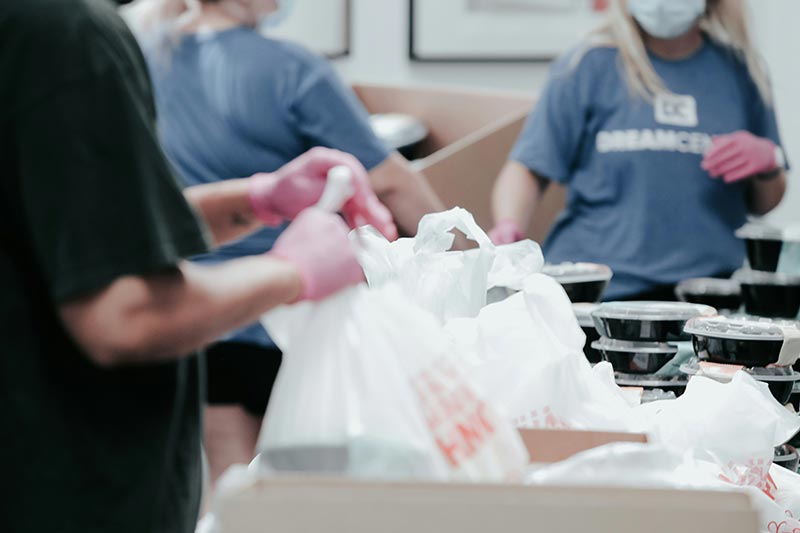“For I was hungry and you gave me food…”
Helping the hungry

In the United States and Canada many charitable organizations and church groups have stepped up over the years to provide critical support to those who cannot get the foods they need for a healthy life.
The US Department of Agriculture has created a term “very food insecure” to cover the food needs that vary from the homeless to those who experience a lack of food occasionally during the year. The latter may be families with children or the elderly on very limited incomes. The types of expenses that can happen, that mean families are unable to buy enough food, include major car repairs, medical expenses including high cost prescriptions, huge rent increases, etc. Finally, especially in our Covid-19 days, loss of employment can create havoc with family finances.
The number of people who are food insecure is, of course, an estimate. In the United States the US Department of Agriculture estimates the number of “very food insecure” individuals to be about 14 million. Many are children.
While food banks are in place and are doing a wonderful job, they rely not only on donated foods and household supplies, but also donated time (volunteers) and funds. The funds are needed to cover the costs of their facilities and their poorly paid staff. Volunteers can be individuals with a passion for love of neighbor (Rom. 13:9-10), or who see the poor and hungry as the least of Jesus’ brothers (Matt. 25:34-35). Volunteers can sometimes be a group of individuals who all know each other. Doing acts of love together can be a wonderful experience which simply delights our Lord.
A Terminology Note
In the US a “food bank” is a warehouse-like facility for receiving food donations from grocery stores, restaurants, farmer’s markets and produce distributors. They sort, inspect, and re-package these foods. The food bank then distributes the foods to the front-line groups that in turn make them available directly to those in need.
The front-line groups are soup kitchens, homeless shelters, senior care facilities, and “food pantries”. Food pantries are locations that stock a supply of foods for those in need to come by and pick up. Food pantries are often found in church buildings.
In Canada, “food bank” also describes a place that provides foods directly to those in need. Some Canadian food banks may be a blend of a US food pantry and a soup kitchen. On the other hand, some operate like a US food bank; they are usually called “food bank hubs”.
Finding Opportunities in the United States
One of the major hunger-relief charities in the US is “Feeding America”. It operates about 200 food banks; their locations can be found at www.feedingamerica.org/find-your-local-foodbank. The websites for each location have a webpage to volunteer your time (and of course, to donate). There are, of course, many other food banks in the US; a Google or Google Maps search will find one nearby.
One example of Feeding America’s work is a built-up, four county, area of SE Florida. The total population of these four counties is 6.27 million. Last year Feeding America’s food bank serving these counties, through their partner agencies, provided 706,000 individuals with additional needed food, of which 236, 000 were children and 100,000 were elderly. These numbers represent 11% of the population.
This year they, and many other food banks across the country, estimate food needs have doubled due to Covid-19 unemployment. Part of their response has been to build a kitchen facility on site, eventually capable of producing 10,000 meals a day by hiring otherwise unemployed restaurant chefs.
To see examples of the impacts of Covi-19 on people in the United States, take a look at the photos at
www.motherjones.com/food/2020/04/these-photos-show-the-staggering-food-bank-lines-across-america/.
Most food banks are very large warehouse operations. Volunteer work involves unpacking, inspecting, sorting and re-packing.
The partner agencies working with food banks can also need both volunteers and financial support. The food pantries in the US can be located at https://foodpantries.org. We have not found a similar and comprehensive directory of soup kitchens.
Finding Opportunities in Canada
In Canada, as we said above, “food banks” are more directly involved with distributing food to the needy than are “food banks” in the US. www.foodbankscanada.ca has a directory, listing some 650 of these independent food banks. About 130 of these are in southern Ontario. As an example of Canadian needs, the site reports 1.1 million visits to food banks in the month of March 2019. That’s 3% of all Canadians in just that one month, with no doubt each visit representing a number of others who also needed food.
Some of the food banks in Canada are quite similar to the food banks in the US, collecting food supplies and providing them to the more direct-to-the-hungry food banks. One example is the Hamilton Foodshare (www.hamiltonfoodshare.org). They provide the food supplies to 12 local area food banks and hot meal programs.
10 ways for individuals and ecclesias to love their neighbors: the hungry ones.
- Do an online search, find your local food pantry, food bank, soup kitchen and homeless shelter.
- Volunteer as an individual – find out what it’s like.
- Organize an ecclesial group to volunteer all together – maybe once every month. If necessary, use up a half day of vacation.
- Have a food collection Sunday once a month for a nearby food pantry, food bank, soup kitchen or homeless shelter. Remember to include things like soap, shampoo, and paper products.
- Collect funds several times a year for your preferred nearby charity – or several of them.
- Set up a food pantry at your ecclesial hall. Make it available (quietly, privately) to ecclesial members each Sunday.
- Prepare peanut butter sandwiches for a local homeless shelter or soup kitchen. Pre-arrange with them. Organize a group at your ecclesia to do this on, say, a Sunday afternoon. Peanut butter sandwiches do not need refrigeration, so can be delivered to the recipient on Monday. Think in terms of preparing many hundreds!
- Arrange with a local senior center or homeless shelter to serve the residents breakfast. You can choose a hot breakfast or healthy cold items. Whatever you choose will be a welcome break from their normal.
- Make the ecclesial food pantry available to the public for a few hours once a week via a drive-through distribution of standardized boxes of food and paper products. The boxes can be pre-assembled by ecclesia members on a scheduled Saturday or Sunday afternoon. Figure out how to advertise the distribution.
- Before doing any support activities that will result in the public being on your ecclesial property (either inside or just in the parking lot), you will need to assure the ecclesia has adequate liability insurance. There may also be zoning ordinances and local regulations about traffic, safety, health, access for the disabled, and operation of a public charity you would need to comply with. Finally, consider any adverse impact on your neighbors and the neighborhood in which your ecclesial hall is located.

